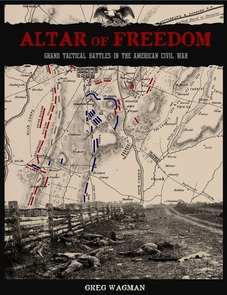You know the saying "I need
[insert name of thing you don't need here] like I need a hole in the head", well yes it's that, although I could do without any additional holes. This time it's the American Civil War. By way of explanation or possibly excuse I should state that after ancient period wargaming the other big period I used to game was the American Civil War in 20mm using Airfix figures. This stemmed in part from my having been an ACW re-enactor back in the 1970's before I became embroiled in the homegrown variety of civil strife.
 |
| It's "The Mild Bunch" circa 1977. |
A few days ago while browsing the web I came across a review of a set of rules called 'Altar of Freedom' and they sounded like they were using some interesting mechanisms. They were available on Wargames Vault for $15 with scenario books for the major battles in the Eastern and Western Theatres for an additional $15 each, available for a simple couple of clicks of a mouse button. Online purchases, its what we do in lockdown and it was my birthday on Sunday and they come as a PDF so no incriminating parcels. Did I mention that the recommended scale is 6mm too. It's not my fault it was more than mere flesh could bear. So I bought a set of the rules and the Eastern theatre scenarios.
 |
| Nice cover art work too |
Lets say right from the off these are not rules that work well for solo gaming (although I'm going to see what I can do about that). This is because of the activation and game turn length mechanisms. The whole point of the rules is to have a live opponent. What they do cover really well is the grand tactical level command and control issues that the Army Commander focuses on. Each manoeuvre element is a brigade, there is no micromanagement of Regimental formations to worry about that's happening down the chain of command and is beneath the interest of the Army command. No this is a game that focuses on the bigger picture with the objective being that full scale ACW battles can be fought on a reasonable sized table (the biggest needed is 6 feet by 4 feet). They are tailored to refights of actual battles rather than fictional encounters or point based competition encounters which suits me fine.
The rules a short, crisp and have the minimum of modifiers to combat. The core of the game is the activation bidding system. Each player has Army and Divisional commanders represented on the table. These all have command points available plus some traits that may impact how they can allocate those points, along with some which impact on other things such as combat. At the start of the turn those points are allocated between divisions to determine the sequence of activation. Highest bids go first. Points can only be applied to units in that general's chain of command. Some points can be held back to be used in the admin phase at the end of the turn (where reserves can be moved and units may attempt to rally amongst other things. The other important use of these points is to gain control of the turn clock. The turn clock has a value ( determined by the scenario) after each group of divisions on the same bid value have moved and fought both players throw a dice and the player who controls the clock decides which one to use. The value on the chosen dice is deducted from the turn clock and then the next set of divisions are moved at the end of those divisions turns the players throw the dice again to count down the turn clock. Once the turn clock passes zero the turn ends. So by having control of the turn clock a player who needs to do a lot in a turn can choose the lowest dice rolls and delay the end of the turn or if they want to block the oppositions plans they choose the higher dice rolls. this can be useful if there are a lot of reserves needing to be brought up or broken units to rally. Although its a bit 'gamey' it does allow the impact of generalship to be modelled. The traits assigned to generals reflect their performance on the day of the battle so as army commander the player has to deal with the personalities. This is something I really like.
The units are generic brigades on standard bases which makes creating the units easy. They have a numerical modifier to reflect larger or smaller formations or a better or worse performance at a particular engagement allocated for each battle.
The scenarios cover the major battles of the war with a tablelayout, order of battle and specific traits for the relevant commanders for that battle. These vary from battle to battle to reflect how they behaved on that specific day.
Of course this being me a confirmed 6mm player I decided to try the rules using 2mm figures as the recommended scale for buildings is 2 mm. Plus I can make markers quickly and easily to get up and running. In due course I may use 6mm figures, or I may not!
The website for the game is excellent (a real plus in favour of the rules in fact) there are free introductory scenarios to download, a free Gettysburg campaign rule set (also free) and a select of paper building's to make (again free). These can be found here
https://www.6mmacw.com/ along with the rules and other helpful advice on building terrain.
So I have a start on Brigade bases and terrain. So its "On to Richmond" next with a try out of First Manassas as soon as the rest of the units are done.











